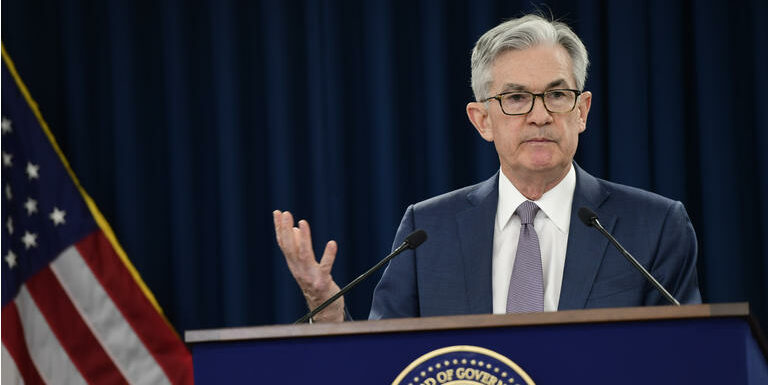
- U.S. stocks continued their auction on Monday as government security yields kept on traveling up, a clue that numerous dealers are sure the Fed will before long climb rates.
- Dealers say the tension on U.S. stocks isn’t because of material worries about the economy, yet portfolio repositioning for higher getting costs.
- “Presently you have the potential for financing costs, which seemed like they probably won’t begin going up until June,” said Charles Schwab’s Randy Frederick. “Presently there resembles a 80% likelihood that will occur in March.”
Central bank Chairman Jerome Powell talks during a House Finance Committee hearing in Washington, DC on Wednesday, December 1, 2021.
U.S. stocks continued their auction on Monday as government security yields kept on traveling up, a clue that numerous dealers are developing more sure that the Federal Reserve will move in the following not many months to raise financing costs.
As the country’s national bank, the Fed is entrusted by Congress to boost work and keep costs stable. The Fed changes transient financing costs and other liquidity devices to keep expansion around 2% and cut joblessness however much as could reasonably be expected.
Dealers say the tension on U.S. stocks isn’t because of material worries about the economy or fears of a huge Covid-19 resurgence, however portfolio repositioning for a world with higher getting costs.
At the point when the Fed discovers that the economy is near full business – and particularly assuming expansion is hot – it climbs financing costs to make it harder for firms to acquire and to keep a cover on spending that fills cost increments.
Many market watchers, including Charles Schwab’s Randy Frederick, say hot expansion prints everything except ensure Fed rate climbs before very long. Individuals from the national bank have effectively transmitted that they intend to confine admittance to cash quicker than first expected.
The Labor Department announced in December that the costs that customers pay for labor and products rose over 6% in November and scored their biggest year-over-year bounce starting around 1982.
Frederick, head of exchanging and subsidiaries at Schwab Center for Financial Research, clarified that the market seemed, by all accounts, to be surprised by Chairman Jerome Powell’s turn away from referring to expansion as “passing” and toward more prohibitive money related arrangement.
Those assumptions have sent the yield on the benchmark 10-year Treasury note higher lately, with the rate last seen up around 1.77% from a low under 1.4% in December. Developments in the 10-year yield can ultimately straightforwardly affect buyers through higher home loan rates and automobile credits.
“Those are the two endeavors pointed toward battling the rising expansion, which I think has gone a lot farther and a lot quicker than [Powell] had expected,” he said. “So presently you have the potential for loan costs, which seemed like they probably won’t begin going up until June. Presently there resembles a 80% likelihood that will occur in March.”
Monday’s auction likewise comes a day prior to Powell is set to show up before Congress for his designation hearing. Lael Brainard, whom President Joe Biden selected to be the national bank’s next bad habit seat, will affirm on Thursday.
Advertises now believe there’s a 76% possibility the Fed climbs loan fees at the March meeting of the Federal Open Market Committee, up from around 15% in mid-October, as indicated by the CME Group’s FedWatch site.
Frederick isn’t the only one in that reasoning. The Fed’s most recent gathering minutes, combined with hot expansion and close full business, drove Goldman Sachs to let customers know that it currently expects four rate climbs in 2022, more than recently anticipated.
Among the three significant U.S. value lists, merchants’ new selling has been moved in the stocks that include the tech-weighty Nasdaq Composite. The Nasdaq is 8.5% underneath its unequaled high contrasted with a 3.5% plunge for the S&P 500 and a 2.7% drop for the Dow industrials. The Russell 2000, a list that tracks more modest public organizations, is over 12% beneath its record.
Administrators disturbed by rising costs at the service station and at supermarkets, are relied upon to barbecue Powell on how he and his partners at the Fed intend to pack expansion down back toward the Fed’s 2% objective.
“In the tech area, which will in general exchange at an extremely high valuation, there are heaps of new organizations that have obligation and influence,” Frederick said. Those organizations could make some harder memories keeping cash available “in light of the fact that when that obligation terminates, it should be supplanted at a higher rate.”
Be that as it may, higher rates — or market assumptions for higher rates — can cause monetary indigestion as merchants sell Treasury securities and lavishly evaluated values.
Areas and stocks thought about more monetarily protective, with better close term benefit assumptions, beat. Utilities firms like Xcel Energy and Duke Energy acquired while drug producers Merck and Amgen rose 2% and 1%, individually.

Elena is a well known author. She is born and raised in Tampa. she graduated from The University of Tampa with an English and Creative degree. After beginning her career in content creation and copy writing, she joined the Financial Reporting 24.
Disclaimer: The views, suggestions, and opinions expressed here are the sole responsibility of the experts. No Financial Reporting 24 journalist was involved in the writing and production of this article.

